SLLA580 December 2021 ISOUSB111 , ISOUSB211
1 Application Brief
Introduction
The use of the Universal Serial Bus (USB) has grown in industrial applications: for software uploads and configuration, diagnostics, maintenance, and connecting peripheral modules such as Wi-Fi routers, display screens, and human-machine interface (HMI) modules.
Since USB was primarily defined as a consumer electronics interface it is not inherently capable of handling large noise disturbances, ground bounce and ground potential differences that are common in industrial applications. In some applications, such as Uninterrupted Power Supply (UPS), controllers with the USB interface are on the high-voltage or ‘hot’ side, needing protective isolation to the USB connector. System designers also worry that any faults or ESD events on the exposed USB connector could interfere with the functionality of the industrial equipment. Due to these reasons, galvanically isolating the USB interface has become necessary in a broad spectrum of applications including factory automation, motor drives, medical equipment, power delivery, e-meters and data concentrators, in-flight entertainment and gaming consoles.
In this application brief, we discuss new isolated USB solutions from Texas Instruments, and their benefits over existing solutions.
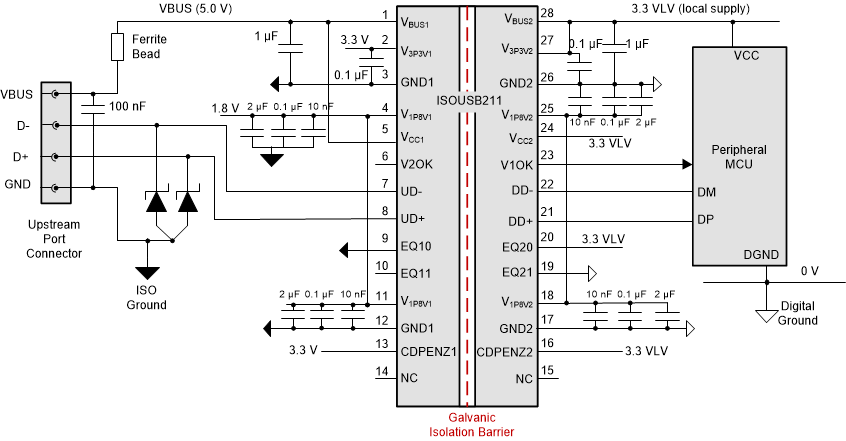 Figure 1-1 Isolating an Existing USB 2.0
HS Port with Minimum Components using ISOUSB211
Figure 1-1 Isolating an Existing USB 2.0
HS Port with Minimum Components using ISOUSB211New Solutions for Isolated USB
Texas Instruments’ ISOUSB211 and ISOUSB111 devices are isolated USB repeaters that are compliant to USB 2.0 standard. Both devices offer basic and reinforced versions, with isolation rating up-to 5.7 kVRMS, surge test voltage up to 12.8 kV, and working voltage up to 1.5 kVRMS.
Figure 1-1 shows how an existing MCU high-speed USB 2.0 port can be easily isolated with ISOUSB211.
ISOUSB211 supports High Speed (HS, 480 Mbps) operation in addition to Full Speed (FS, 12 Mbps) and Low Speed (LS, 1.5 Mbps) modes and has the following benefits vs. existing solutions:
- ISOUSB211 is the first USB 2.0 compliant isolated repeater to support 480 Mbps data-rate, compared to 12 Mbps of older solutions. Higher data rate enables quick transfer of large firmware and diagnostic files, low-latency communication, real-time applications like video displays and data-logging, and backplane communication.
- Automatic Upstream-Downstream role detection and role reversal, allowing applications like OTG and Type-C dual-role port and allowing the same part number to be used for host, peripheral, hub or cable isolation.
- 50% smaller footprint than equivalent competing solution.
- Easy to use solution that meets High Speed Signal Quality without needing external crystal oscillator or clock input. The incremental jitter is added by ISOUSB211 is low enough to meet USB eye-diagram specification without re-timing. Figure 1-2 shows the high-speed eye-diagram obtained by connecting ISOUSB211EVM in series with a USB 2.0 compliant golden host (PC).
- Built-in, adjustable equalization and pre-emphasis that can compensate for insertion losses and ISI caused by board traces and internal cabling, providing flexibility for system design.
- Charging Downstream Port (CDP) signaling according to Battery Charger 1.2 (BC 1.2) standard for hosts that look to advertise >1.5 A power delivery on the VBUS connector.
- Indication of Upstream VBUS state on the downstream side, enabling indication of host attach in peripheral mode.
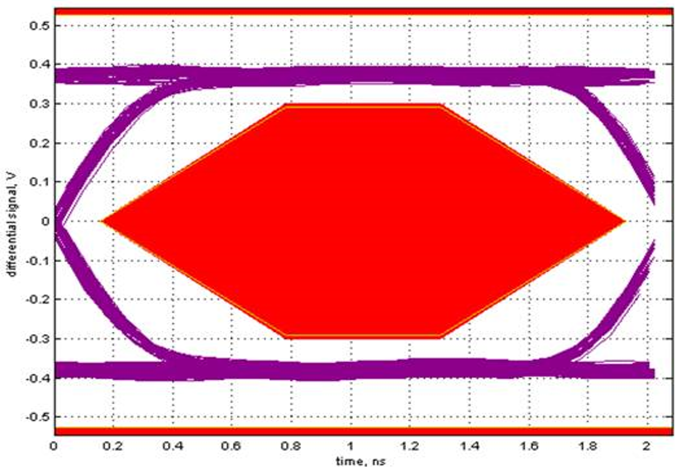 Figure 1-2 ISOUSB211 Eye-Diagram When
used with USB 2.0 Golden Host PC
Figure 1-2 ISOUSB211 Eye-Diagram When
used with USB 2.0 Golden Host PCISOUSB111 supports LS and FS modes for applications that do not need high bandwidth, with the following advantages over the current solutions:
- More than 20 dB lower emissions that ease compliance to CISPR32 Class B standard.
- 16-SSOP package option (DWX) that is 40% smaller in size than the smallest existing solution in the market, in addition to a 16-SOIC option (DW) pin compatible with competition.
- Indication of Upstream VBUS state on the downstream side, enabling indication of host attach in peripheral mode (available in DWX option) .
Figure 1-3 shows how an existing MCU full-speed/low-speed USB 2.0 port can be easily isolated with ISOUSB111.
CISPR32 Class B Emissions
EMC performance is a key care in industrial applications. Figure 1-4 shows the comparison of ISOUSB111 emissions performance with an equivalent competition device. The test setup was communication between a PC and a USB drive through ISOUSB111 and a 1 meter cable. ISOUSB111 has more than 20 dB lower emissions than competition and easily meets the CISPR32 Class B limit, while the competing device shows emissions higher than the limit.
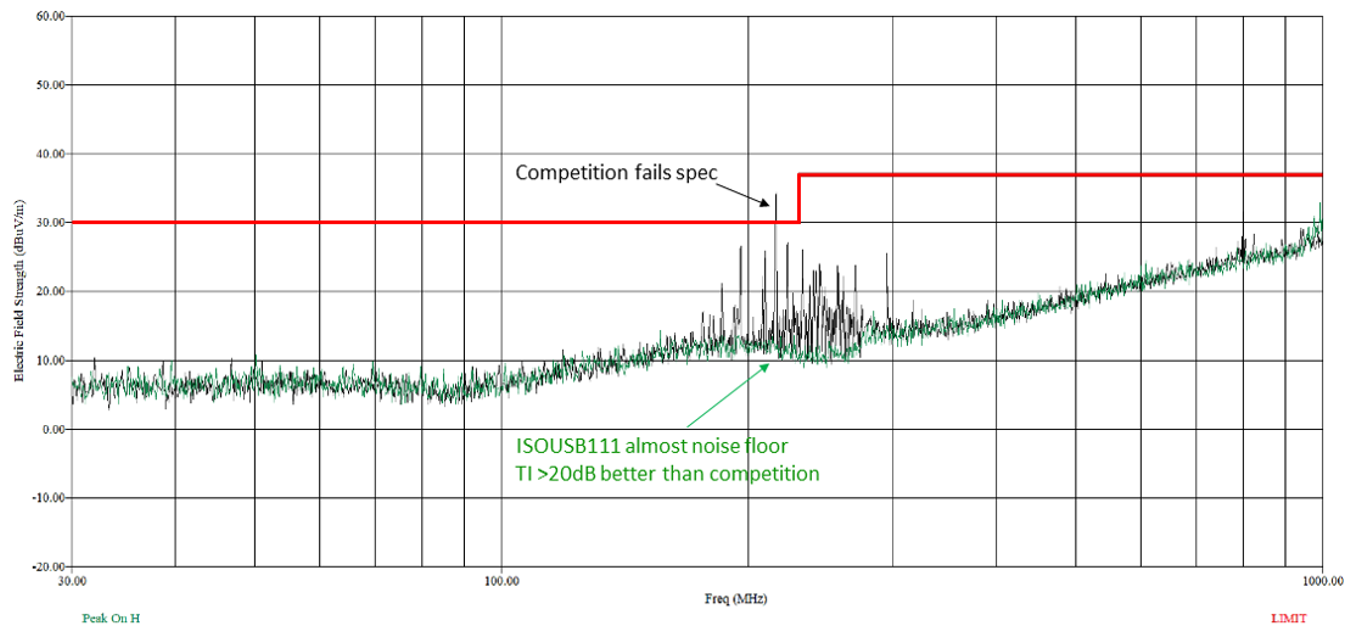 Figure 1-4 ISOUSB111 CISPR32 Class B
Emissions Compared to Competition
Figure 1-4 ISOUSB111 CISPR32 Class B
Emissions Compared to CompetitionFigure 1-5 shows ISOUSB211 emissions performance. The test setup was communication between a PC and a USB drive through ISOUSB211 and a 1 meter cable. ISOUSB211meets the CISPR32 Class B limit with margin. The noise peaking around 80 MHz is coming from isolated power converter included on the ISOUSB211EVM and not from ISOUSB211.
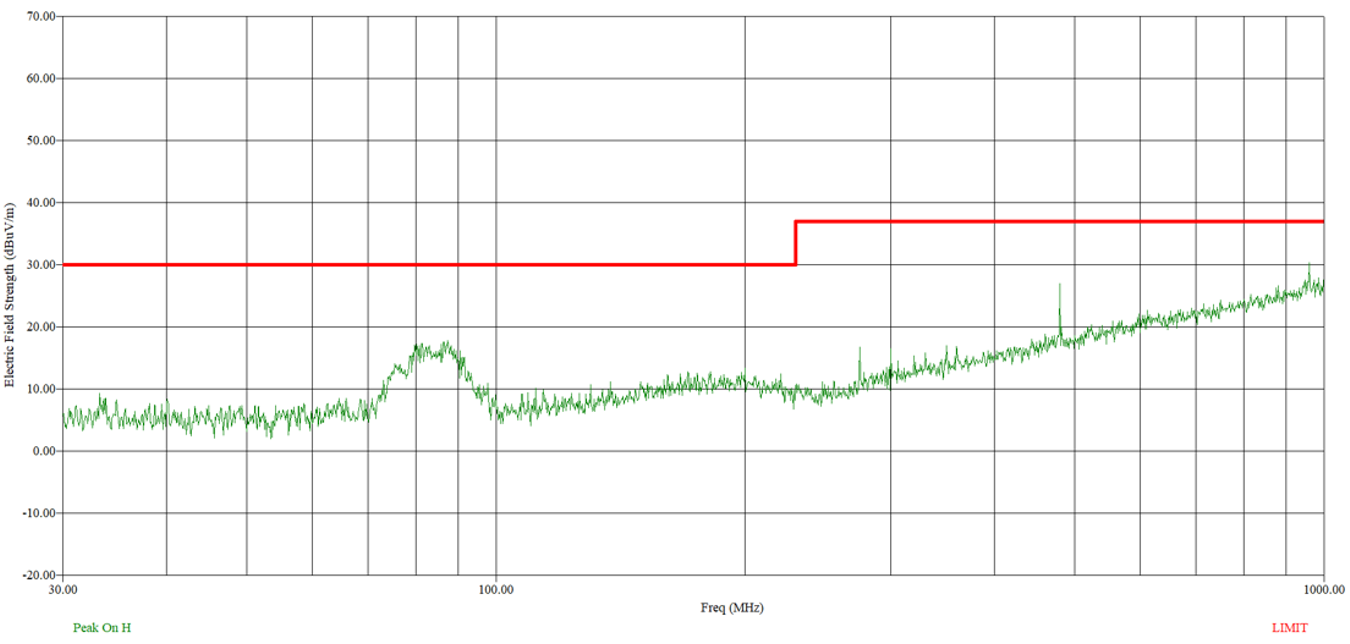 Figure 1-5 ISOUSB211 CISPR32 Class B Emissions
Figure 1-5 ISOUSB211 CISPR32 Class B EmissionsComparing ISOUSB211 and ISOUSB111 with Competing Solutions
Figure 1-6 shows a summary of the ISOUSB211 and ISOUSB111 comparisons with competition that were discussed in the preceding sections.
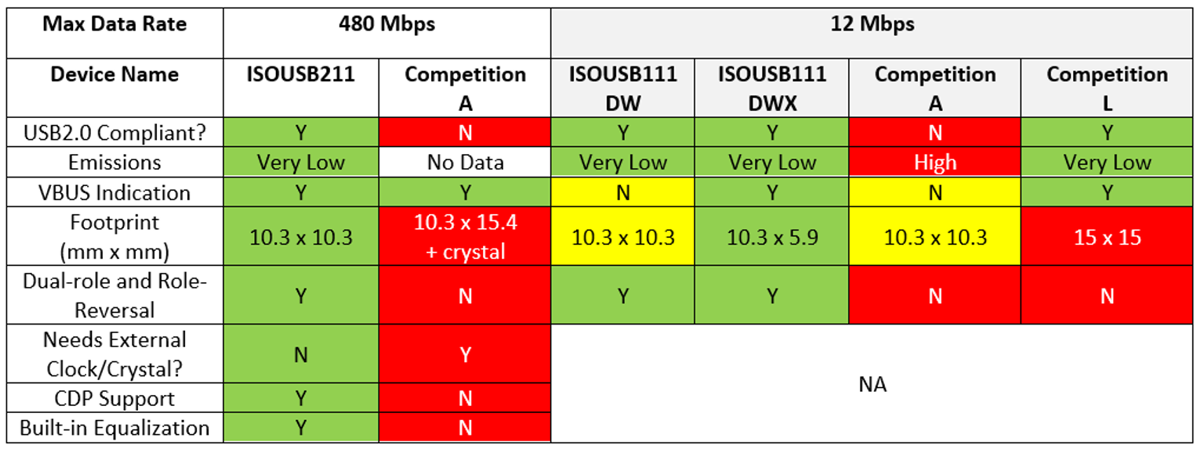 Figure 1-6 ISOUSB211 and ISOUSB111 vs.
Competition
Figure 1-6 ISOUSB211 and ISOUSB111 vs.
Competition